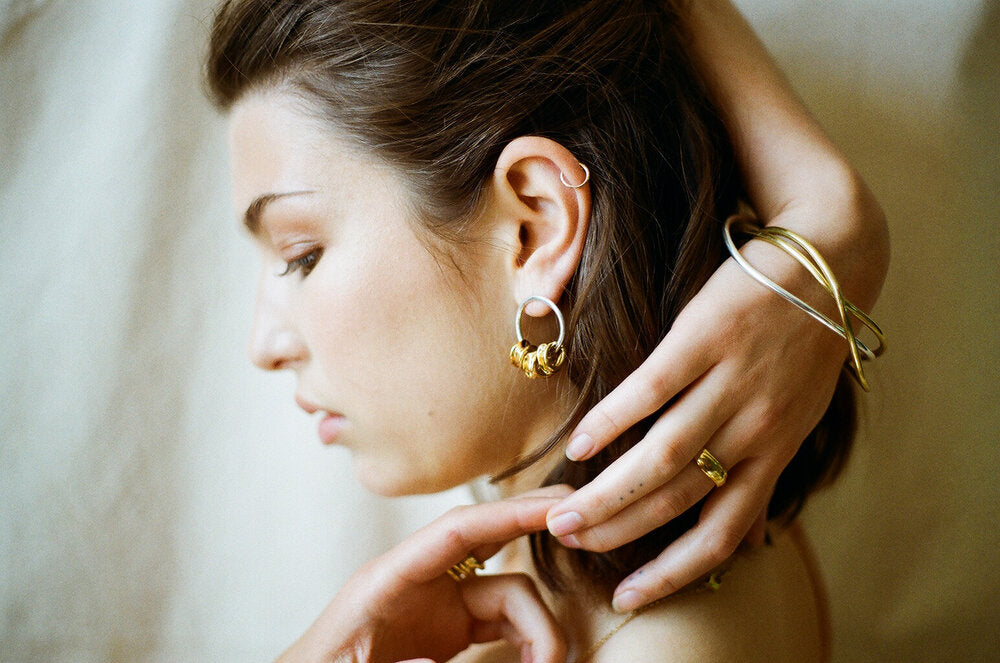
Bold as brass
Share
You may have read our journal or seen our recent social media posts about ending our use of gold plate. This has been a tricky decision for us, as many of the jewellery styles that feature the gold plating are very popular with our customers.
In this journal, we want to share some of the information that led to our decision.

A Little History…
Gold plating has been used commercially since the 1800s as a way to mimic the look of solid gold without the heavy price tag. For this reason, it’s an extremely popular choice. Its cost-effectiveness starts to wane however when you dig a little deeper. As always we want items to be accessible to all but prioritise a regenerative approach.
Chemicals
To plate other metals in gold, a number of chemicals are used, including acid cleaners, alkaline cleaners, abrasives, solvents and cyanaurate (cyanide.) Disposal of these chemicals threatens ecosystems, which we simply do not want to risk contributing to.
Non-recyclable
Once an item has been gold plated, it can only be recycled if the gold is stripped away. This process is labour intensive and difficult if done by sanding, and uses more harmful chemicals to strip the gold if done at an industrial scale.
Mining
‘Ethical’ gold plate is now available from certain distributors of gold plating. This gold is Fairmined, which plays a huge part in protecting the rights of those working in the mining industry. However, it does not account for the environmental impact of extracting gold for plating or the process of plating itself.
Longevity
Gold plating if looked after will last a couple of years. However, over time, the gold will wear away leaving you with a patchy coloured piece. Items can be re-plated, but this is far from ideal. We want our products to last you a lifetime, products that degrade after a few years just don’t speak to our brand ethos. We don’t want to support the consumption of products that won’t last.
Environmental threats
The precious metal plating industry poses huge environmental threats from chemicals. In recent years there has been a move towards ‘green chemical’ development for metal plating. Though this would appear a positive move, this has driven the growth of the global metal plating chemical market and precious metal plating industry in general, expanding energy and chemical use in production.
Cleaning
Gold plating is a very thin layer of gold. This makes it difficult and near impossible to clean without removing the gold plate in the process.
All new collections from January 2021 will offer items in solid recycled brass, silver and gold ·
We often get asked about brass so here’s a little more information on this durable and warm material...
Why Solid Recycled Brass?
Using solid recycled brass and is a great alternative to achieving a golden aesthetic whilst avoiding the environmental damage of gold plating.

Longevity
If cleaned and cared for, brass items will stay looking fresh for years.
Easy care
Brass is really easy to clean and care for. With some love and attention using our tips, you can bring back the shine of brass quickly and easily time and time again!
Your Questions Answered
I have sensitive skin, will wearing brass be an issue for me?
Lots of people are allergic to different metals, which is why we offer recycled solid gold, silver and brass to choose from. All of our earrings are made with solid silver or gold posts and scrolls.
Will it make my skin green?
Brass when worn on the skin for a while will leave a greenish mark.
This is just the brass oxidising against your skin; it is not toxic or permanent and washes of easily. You mostly see this with rings and jewellery that sits against the skin. Our cleaning tips also offer ways to avoid this.
If you have any further questions about this change to the business please do not hesitate to get in touch via emma@emmaaitchison.com
